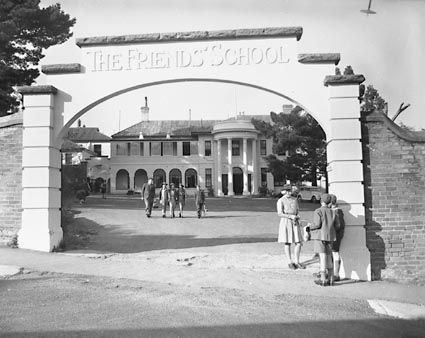Established 1887 Employees ~200 Colour(s) Blue, Red & Grey Motto Nemo Sibi Nascitur | Principal Nelson File Enrolment ~1,330(PK–12) Phone +61 3 6210 2200 Founded 1887 | |
 | ||
Type Independent, Co-educational, Day & Boarding School Address 23 Commercial Rd, North Hobart TAS 7000, Australia Profiles | ||
The Friends' School, Hobart is an independent, co-educational, Quaker, day and boarding school, located in North Hobart, a suburb of Hobart, Tasmania, Australia.
Contents
Founded in 1887 by Quakers, the school currently caters for approximately 1330 students from Pre-Kindergarten to Year 12, including 47 boarders from Years 7 to 12. It is the largest Quaker school in the world.
Friends' is affiliated with the Association of Independent Schools of Tasmania (AIST), the Junior School Heads Association of Australia (JSHAA), the Association of Heads of Independent Schools of Australia (AHISA), the Australian Boarding Schools' Association (ABSA), and is a member of the Sports Association of Tasmanian Independent Schools (SATIS).
History
The Friends' School opened at 60-62 Warwick Street, Hobart (the building still stands) on 31 January 1887 under the control of the Religious Society of Friends (Quakers). It was opened by Samuel Clemes. The initial enrolment of 33 expanded so rapidly that the School moved to its present site in Commercial Road on 28 January 1889, a move made possible by the generous loan of A$4,000 from Hobart Baptists. The first headmaster was Samuel Clemes, considered to be a remarkable reformer in education for his belief in co-education. In 1900 he resigned and set up his own family school, Leslie House, (later renamed Clemes College) in Pirie Street and then at Boa Vista, Argyle Street, where Morris Friends' Primary Years (Junior School) and Clemes (Years 11-12) are now located. Clemes College and The Friends' School came together in 1946.
1923 marked the beginning of a new era in the School's history. On 28 September, the control of the school passed from London Quakers to a committee in Hobart and a week later Ernest Unwin arrived, under whose leadership the School made remarkable progress. In this period the distinctive appearance of the School changed - with the addition of the front portico, the Hodgkin Hall, the original science and art block and the boys' boarding wing. No further building programmes were undertaken until 1955 when the second period of expansion began with the opening of the Preparatory School in 1955 followed by the Sports Ground in 1958. Building on the Commercial Road site began in 1962 with the opening of the Unwin Memorial Science and Art block, continued in the 70s with the Library, the Asten Theatre, additional science facilities and in the 80s with the W.N. Oats Sports Centre. The Clemes Memorial Library in the Junior School was erected from the old Clemes Assembly Hall in 1986. The addition of the multipurpose Farrall Centre to the Junior School was completed in late 2011.
Despite being a Quaker school, there are no more than 10 Quaker staff at the school, and few of the students are actually Quakers. However Quaker activities, such as meeting for worship (Gathering), form an integral part of school life for students, and take up one hour per week.
Sherwood
Following the Tasman Bridge disaster of 1975 many students of the school who lived on the eastern shore of the Derwent River became isolated, and were unable to attend. Some students of other schools were re-allocated to the limited eastern shore schools, but places were insufficient, and the educational standard was generally considered lower than Friends.
Whilst older students were trusted to make the ferry crossing from Bellerive to Hobart, for younger students it was not deemed safe to do so unsupervised. Appeals were made to the school from concerned parents, and eventually it was decided to build a temporary campus within the Clarence. A site was located in bushland above Lindisfarne and a small area was set aside for the campus.
The Sherwood campus consisted of two main inter-linked buildings, a playground, a crude gravel oval and a large area of undeveloped bushland. The school only catered for pupils from kindergarten to grade 2, as it was considered older pupils were old enough to catch transport to the main campus.
One of the features of the education system at Sherwood was the regular "nature walks" in which students from every year group would participate in regular excursions into the nearby sclerophyll bushland and learn to understand, appreciate, and get in better touch with nature.
It closed just a few years after opening.
Principals
Complete list of School Principals:
Structure
The Friends' School consists of three main parts: Morris Friends' Primary Years, High School and Clemes. Morris has approximately 430 students from Kindergarten to Year 6 and is situated in the Argyle Street Campus. The High School has 550 students from Year 7 to 10 and is in the Commercial Road campus. Clemes has approximately 300 students in Years 11 and 12 and is in the Argyle Street campus.
The School also owns a sports complex at Bell Street where there are facilities for cricket, hockey, softball and soccer, Friends' Health and Fitness off Elizabeth Street and Friends' Early Years on Argyle Street. The School also has a state-of-the-art rowing facility located in Lutana, close to the school's main campuses.
For the purpose of both class allocation and internal competition, all students at Friends' are allocated into "Houses" within the School. The primary school houses are composed of Benson, Cadbury, and Cooper. In the secondary, Mather, Ransome, Unwin, and Hodgkin make up the houses.
All students in the High School are members of tutor groups. Tutor groups consist of approximately four people from each grade in the High School, creating a total of around sixteen people. The school tries to place two girls and two boys per grade per tutor group, but there are exceptions. All members of a tutor group are in the one house, and each house has eight tutor groups.
